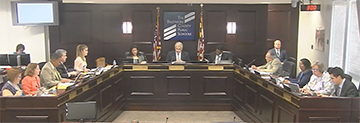
The Baltimore County Board of Education, which develops and reviews policy for a 113,000-student population that is 60 percent minority, has just one minority board member. Those decisions board members help shape ranged from those involving technology and grading policies to whether schools should be closed for Muslim holidays to how to draw school boundaries and prioritize school construction and renovation needs.
For at least the past five years, there were two African-American and one Hispanic individual on the board for Baltimore County Public Schools. Since May, two of the three minority board members resigned—Romaine Williams and Marisol Johnson.
The Governor, who has the authority to appoint their replacements—chose Roger Hayden, a former county executive and BCPS superintendent to fill the vacancy left by Williams, rejecting appeals from community leaders and elected officials to retain the diversity that reflects the student population. Johnson’s replacement has not been appointed.
Leaders expressed dismay and disappointment that the 12-member school board is now comprised of 11 Caucasian members and one African-American member, Charles McDaniels Jr. who represents the fourth councilmanic district.
The Baltimore County student population is made up of 40 percent white, 39 percent black and 21 percent other minority students. That compares with less than 9 percent minority and 91 percent white representation on the board.
Romaine Williams, an attorney who chaired the board’s influential policy review committee, was appointed in 2013 to fill the term of another African-American female board member. Williams announced her retirement at the April 18 board meeting, indicating that she and her husband were moving to Harford County to be closed to her daughter, son-in-law and grandson. “It is my hope that equity, excellence and joy remain at the forefront of the work of the board,” Williams stated.
Most recently, Williams advocated assertively to reverse the heat policy, giving the superintendent authority to close schools instead of using a heat index, and to close schools on Muslim holidays.
Marisol Johnson, a Hispanic board member for the past five years who represented councilmanic District 2, announced her resignation at the end of the June 13 board meeting.
Johnson, vice chair, said at her last meeting that “the timing to go is perfect for me and my family” and she looks forward to the future.
“I have learned that if you don’t grow, your knowledge base kind of stay stagnant. I want to make sure I don’t get lost in the minutia of things and things I don’t control,” Johnson during her remarks at the meeting. “I want to make sure that I move on beyond Baltimore County Public Schools and finish what I started here as vice chairwoman on this school system. Moving forward, I won’t stop fighting for all children.”
A group of legislators and community leaders led by Del Ben Brooks of District 10 submitted to the Governor the name of Cheryl Pasteur, a retired teacher, department head and principal of Randallstown High School who continues to spearhead various education initiatives. Brooks said the nomination would have reflected and maintained the geographic, gender and racial diversity of our county.
Other submissions include Treopia Washington, a former educator who has held education positions in corporate and nonprofit organizations.
In a June 15 letter to the Governor, Aaron Plymouth, chair of the Combined Communities Advocacy Council of Greater Randallstown, expressed disappointment about the disproportionate representation on the board.
The CCACGR did not recommend a replacement, but asked that Hogan “please review your list of qualified female minority nominees and appoint one of them replace Marisol Johnson.”
District 4 Councilman Julian Jones wrote in May that Hayden’s appointment “represents a dangerous trend that is being set by your Administration that is not representative of the population being served.” Pointing out that all eight of Hogan’s appointees have been white, Jones asked that the Governor pursue equitable and inclusive numbers of appointees in the county and throughout the state.
Brooks said, “Some people might think that diversity doesn’t matter as long as you have what may appear to be individuals on the board with impressive credentials. But it is important that the diversity of our students’ and their parents’ perspectives and the communities from which they come are presented and taken into account.”
Clifford Collins, chair of the Northwest Advisory Education Council, said, “We have a school system that is 60 percent minority and we have one minority representative. The Governor has been petitioned to appoint a minority to the board, preferably a minority woman from District 2. That is important.”
The Board appointed Verletta White as the interim superintendent to replace S. Dallas Dance, who left his post in June. In that role, she will serve as the board’s secretary-treasurer.
Josie Shaffer, a senior at Pikesville High School and member of the National Honor Society, begins her one-year term on the school board this month. In addition to Hayden and McDaniels, other board members are: Edward Gilliss, chair; Kathleen Causey, June Eaton, Julie Henn, Ann Miller, Nicolas Stewart, David Uhlfelder and Stephen Verch.
—Janet Anderson

